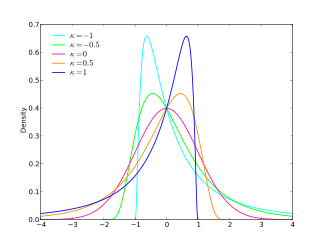Symmetric version
Probability density function  | |||
Cumulative distribution function  | |||
| Parameters | location (real) scale (positive, real) shape (positive, real) | ||
|---|---|---|---|
| Support | |||
| CDF | where is a shape parameter, is a scale parameter and is the unnormalized incomplete lower gamma function. | ||
| Quantile | |||
| Mean | |||
| Median | |||
| Mode | |||
| Variance | |||
| Skewness | 0 | ||
| Excess kurtosis | |||
| Entropy | [2] | ||
The symmetric generalized normal distribution, also known as the exponential power distribution or the generalized error distribution, is a parametric family of symmetric distributions. It includes all normal and Laplace distributions, and as limiting cases it includes all continuous uniform distributions on bounded intervals of the real line.
This family includes the normal distribution when (with mean and variance ) and it includes the Laplace distribution when . As , the density converges pointwise to a uniform density on .
This family allows for tails that are either heavier than normal (when ) or lighter than normal (when ). It is a useful way to parametrize a continuum of symmetric, platykurtic densities spanning from the normal () to the uniform density (), and a continuum of symmetric, leptokurtic densities spanning from the Laplace () to the normal density (). The shape parameter also controls the peakedness in addition to the tails.
Parameter estimation
Parameter estimation via maximum likelihood and the method of moments has been studied. [3] The estimates do not have a closed form and must be obtained numerically. Estimators that do not require numerical calculation have also been proposed. [4]
The generalized normal log-likelihood function has infinitely many continuous derivates (i.e. it belongs to the class C∞ of smooth functions) only if is a positive, even integer. Otherwise, the function has continuous derivatives. As a result, the standard results for consistency and asymptotic normality of maximum likelihood estimates of only apply when .
Maximum likelihood estimator
It is possible to fit the generalized normal distribution adopting an approximate maximum likelihood method. [5] [6] With initially set to the sample first moment , is estimated by using a Newton–Raphson iterative procedure, starting from an initial guess of ,
where
is the first statistical moment of the absolute values and is the second statistical moment. The iteration is
where
and
and where and are the digamma function and trigamma function.
Given a value for , it is possible to estimate by finding the minimum of:
Finally is evaluated as
For , median is a more appropriate estimator of . Once is estimated, and can be estimated as described above. [7]
Applications
The symmetric generalized normal distribution has been used in modeling when the concentration of values around the mean and the tail behavior are of particular interest. [8] [9] Other families of distributions can be used if the focus is on other deviations from normality. If the symmetry of the distribution is the main interest, the skew normal family or asymmetric version of the generalized normal family discussed below can be used. If the tail behavior is the main interest, the student t family can be used, which approximates the normal distribution as the degrees of freedom grows to infinity. The t distribution, unlike this generalized normal distribution, obtains heavier than normal tails without acquiring a cusp at the origin. It finds uses in plasma physics under the name of Langdon Distribution resulting from inverse bremsstrahlung. [10]
Properties
Moments
Let be zero mean generalized Gaussian distribution of shape and scaling parameter . The moments of exist and are finite for any k greater than −1. For any non-negative integer k, the plain central moments are [2]
Connection to Stable Count Distribution
From the viewpoint of the Stable count distribution, can be regarded as Lévy's stability parameter. This distribution can be decomposed to an integral of kernel density where the kernel is either a Laplace distribution or a Gaussian distribution:
where is the Stable count distribution and is the Stable vol distribution.
Connection to Positive-Definite Functions
The probability density function of the symmetric generalized normal distribution is a positive-definite function for . [11] [12]
Infinite divisibility
The symmetric generalized Gaussian distribution is an infinitely divisible distribution if and only if . [13]
Generalizations
The multivariate generalized normal distribution, i.e. the product of exponential power distributions with the same and parameters, is the only probability density that can be written in the form and has independent marginals. [14] The results for the special case of the Multivariate normal distribution is originally attributed to Maxwell. [15]



















































































